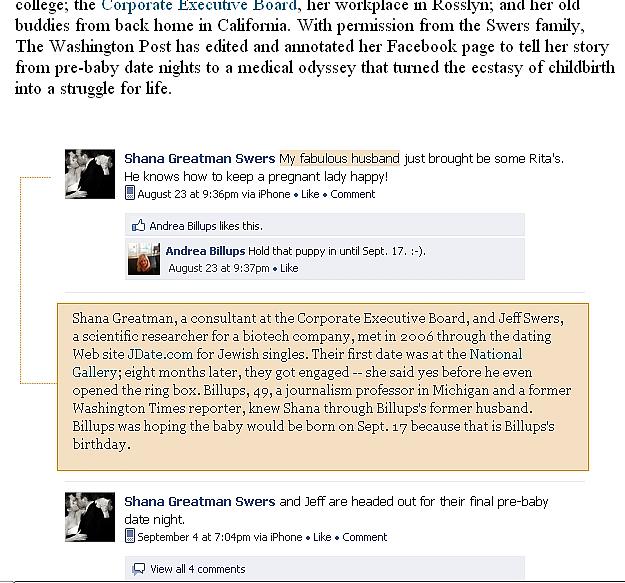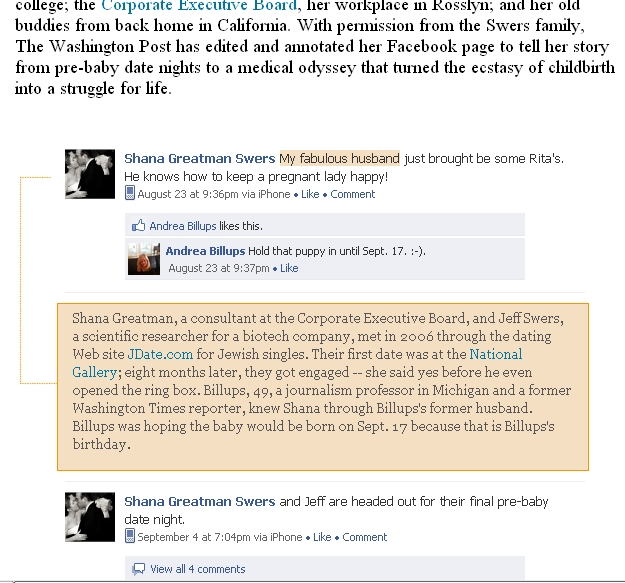Facebook for Journalists: A Washington Post story took finding sources on Facebook a step further

Facebook has 750 million monthly active users, 250 million of whom participate via mobile devices. The average user shares 150 items per month and spends 25 minutes per day on Facebook.
This is what Vadim Lavrusik told journalists at the downtown building of the Los Angeles Times last night. Lavrusik, who was hired as the "Journalist Program Manager" for Facebook in April, made the case for using Facebook as a tool for finding sources, connecting with readers and distributing content.
"We used to search for content, but now content finds us," he said.
 Steve Saldivar rounds up how-tos for using Facebook as a reporting and distribution tool very well, so I won't repeat that here. Instead, I'd like to revisit one very intersting health-related example of Facebook reporting that Lavrusik presented last night. Ian Shapira at the Washington Post created "A Facebook story: A mother's joy and a family's sorrow" last December. Shapira shared the Facebook history of an avid status updater who chronicled her pregnancy and the heartbreaking medical complications that followed. With colleagues at the Washington Post, he then created a custom-designed timeline using Facebook updates and textual annotations (screenshot to the left), creating an intimate story told through many voices that chronicled not only what happened but how family and friends interacted online in difficult times.
Steve Saldivar rounds up how-tos for using Facebook as a reporting and distribution tool very well, so I won't repeat that here. Instead, I'd like to revisit one very intersting health-related example of Facebook reporting that Lavrusik presented last night. Ian Shapira at the Washington Post created "A Facebook story: A mother's joy and a family's sorrow" last December. Shapira shared the Facebook history of an avid status updater who chronicled her pregnancy and the heartbreaking medical complications that followed. With colleagues at the Washington Post, he then created a custom-designed timeline using Facebook updates and textual annotations (screenshot to the left), creating an intimate story told through many voices that chronicled not only what happened but how family and friends interacted online in difficult times.
Shapira answered some critical questions about this kind of storytelling in a live Q&A for the Washington Post. He explained how he found the Facebook-narrated story through personal connections -- the story's subject was his wife's colleague -- and responded to a reader's concern that this kind of storytelling is a gimmick.
I agree with you that this model, if used over and over again, could start to feel gimmicky. But the truth is I couldn't find anything that had been done like this before, at least not by the Washington Post or our competitors. I did find a great video on Gizmodo about the imagined narrative of one man's life, but that was different than what we did with this project. I understand that you may think it's less of a story because there were less of my words, but then again, this is an experiment. We were trying something new. Would we have written a straight-up profile of Shana and her medical ordeal for the Post? I don't know. What elevated her predicament was the way she and her friends talked so openly about such an inherently private matter -- and not only that, they were talking in real time, as she was in the hospital, or heading back to the ER, or already in the ER, and posting from her iPhone. So, the story had to be told from that angle because it embodies something much broader about how we are all communicating these days. The story was about Shana, yes, but in a way, the story was about something much more universal.
The Q&A is worth reading in its entirety. Participants asked questions about depth, the choices Shapira made about which status updates and comments to include, and whether Facebook is an appropriate way to talk about such serious stories at all. While the Facebook and Los Angeles Times-sponsored event was mostly positive about how Facebook can be used by journalists, there were also some interesting side-conversations on Twitter, which I've storified below.
Martin Beck, the Los Angeles Times' social media and reader engagement editor, tweeted that they will post the full video early next week. I'll update this post with that link when it's live.
[View the story "Facebook Journalism Meetup" on Storify]More about Facebook from Career GPS:
Facebook for Journalists: Yay or Nay?
My Favorite Tools for Keeping Up With People on the Internet
SXSW Interactive: Examining health and Facebook with Aimee Roundtree

